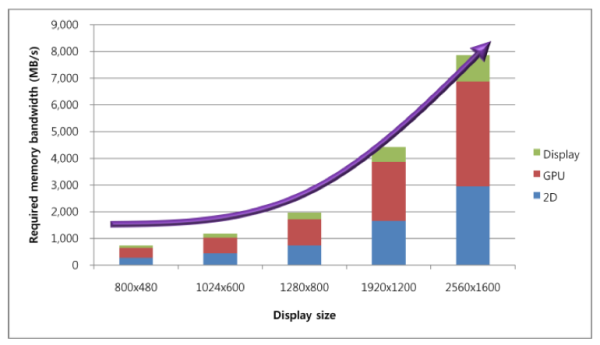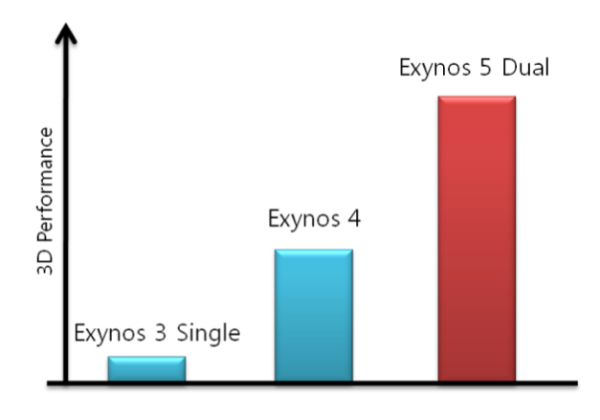Samsung Announces A15/Mali-T604 Based Exynos 5 Dual
by Anand Lal Shimpi on August 10, 2012 3:04 PM EST- Posted in
- Smartphones
- Mobile
- Tablets
- SoCs
Yesterday Samsung officially announced what we all knew was coming: the Exynos 5 Dual. Due to start shipping sometime between the end of the year and early next year, the Exynos 5 Dual combines two ARM Cortex A15s with an ARM Mali-T604 GPU on a single 32nm HK+MG die from Samsung.
The CPU
Samsung's Exynos 5 Dual integrates two ARM Cortex A15 cores running at up to 1.7GHz with a shared 1MB L2 cache. The A15 is a 3-issue, Out of Order ARMv7 architecture with advanced SIMDv2 support. The memory interface side of the A15 should be much improved compared to the A9. The wider front end, beefed up internal data structures and higher clock speed will all contribute to a significant performance improvement over Cortex A9 based designs. It's even likely that we'll see A15 give Krait a run for its money, although Qualcomm is expected to introduce another revision of the Krait architecture sometime next year to improve IPC and overall performance. The A15 is also found in TI's OMAP 5. It will likely be used in NVIDIA's forthcoming Wayne SoC, as well as the Apple SoC driving the next iPad in 2013.
The Memory Interface
With its A5X Apple introduced the first mobile SoC with a 128-bit wide memory controller. A look at the A5X die reveals four 32-bit LPDDR2 memory partitions. The four memory channels are routed to two LPDDR2 packages each with two 32-bit interfaces (and two DRAM die) per package. Samsung, having manufactured the A5X for Apple, learned from the best. The Exynos 5 Dual is referred to as having a two-port LPDDR3-800 controller delivering 12.8GB/s of memory bandwidth. Samsung isn't specific about the width of each port, but the memory bandwidth figure tells us all we need to know. Each port is either 64-bits wide or the actual LPDDR3 data rate is 1600MHz. If I had to guess I would assume the latter. I don't know that the 32nm Exynos 5 Dual die is big eough to accommodate a 128-bit memory interface (you need to carefully balance IO pins with die size to avoid ballooning your die to accommodate a really wide interface). Either way the Exynos 5 Dual will equal Apple's A5X in terms of memory bandwidth.
TI's OMAP 5 features a 2x32-bit LPDDR2/DDR3 interface and is currently rated for data rates of up to 1066MHz, although I suspect it wouldn't be too much of a stretch to get DDR3-1600 memory working with the SoC. Qualcomm's Krait based Snapdragon S4 also has a dual-channel LPDDR2 interface, although once again there's no word on what the upper bound will be for supported memory frequencies.
The GPU
Samsung's fondness of ARM designed GPU cores continues with the Exynos 5 Dual. The ARM Mali-T604 makes its debut in the Exynos 5 Dual in quad-core form. Mali-T604 is ARM's first unified shader architecture GPU, which should help it deliver more balanced performance regardless of workload (the current Mali-400 falls short in the latest polygon heavy workloads thanks to its unbalanced pixel/vertex shader count). Each core has been improved (there are now two ALU pipes per core vs. one in the Mali-400) and core clocks should be much higher thanks to Samsung's 32nm LP process. Add in gobs of memory bandwidth and you've got a recipe for a pretty powerful GPU. Depending on clock speeds I would expect peak performance north of the PowerVR SGX 543MP2, although I'm not sure if we'll see performance greater than the 543MP4. The Mali-T604 also brings expanded API support including DirectX 11 (feature level 9_3 though, not 11_0).
Video encode and decode are rated at 1080p60.
The Rest
To complete the package Samsung integrates USB 3.0, SATA 3, HDMI 1.4 and eDP interfaces into the Exynos 5 Dual. The latter supports display resolutions up to 2560 x 1600. The complete package is the new face of a modern day mobile system on a chip.
Samsung remains very aggressive on the SoC front. The real trick will be whether or not Samsung can convince other smartphone and tablet vendors (not just Samsung Mobile) to use its solution instead of something from TI, NVIDIA or Qualcomm. As long as Samsung Mobile ships successful devices the Samsung Semiconductor folks don't have to worry too much about growing marketshare, but long term it has to be a concern.












36 Comments
View All Comments
nyonya - Friday, August 10, 2012 - link
There's no integrated modem, correct? Does that not bode well for the battery life vs. say the Qualcomm S4, with its integrated LTE radio?vasanthakumar - Saturday, August 11, 2012 - link
Correct. This is the reason why previous Exynos Soc is not shipped in US. Whereas they have used Samsung Krait processor with Snapdragon with integrted Chipset. This Exynos looks to marketing slide. What is Speed of USB3 .. If they tell 5 Ghz. Then the chipset consumes lot of power. USB3 pipe interface is nothing but a Pcie interface where it guzzles power.I think unless they slightly modify A15 processor it will land up taking more power.
LAPE is not a good feature for Mobile devices.
LPDDR3 consumes more power than LPDDR2 ( some people confusingly inter-relate frequency and voltage), But conveniently overlook termination stuff.
C2C more power consuming than MIPI HSI . why it is required. I perfectly under HSIC is a very good interface but latency proplem exists.
Certainly this article is prepared by Marketing team.... (At least slide).
leomax999 - Monday, August 13, 2012 - link
Looks like its directed more towards tablets.There was a news about samsung testing a exynos variant with radio in Korea.
So I'd say the radio integration is coming soon.
2013-14 is shaping up to be exciting time for mobile.
New atom,Infineon coming up with radio and amp in a package.
and possibly atom with radio later on.
Samsung exynos with integrated radio(s).
NV chips with integrated radio.
rd_nest - Monday, August 13, 2012 - link
I think the LTE GS3 (Korean edition) uses Exynos 4 quad with radio and 2GB RAM.vasanthakumar - Wednesday, August 15, 2012 - link
I dont know how samsung will make a integrated radio chips.Even though samsung good at Wireless, unless they make chip it is very difficult to believe
Actual radio cannot be within the chip ( RF chip must be outside).
rd_nest - Friday, August 10, 2012 - link
Couldn't care less about LTE, coz we don't have LTE. good that die space is not wasted for LTE ..those who need LTE can use the S4.BTW, GPU is running at 533Mhz..there were many leaks in past about that.
White paper link: http://www.samsung.com/global/business/semiconduct...
nyonya - Friday, August 10, 2012 - link
Well if not LTE, any air interface - obviously not the biggest deal for tablets but trying to see if it really makes any sense to wait for the Exynos 5 over the S4.dazweeja - Sunday, August 12, 2012 - link
When the Exynos 5 is released, it may not be the fastest then either - Qualcomm will already have shipped the quad-core S4 Pro with Adreno 320.leomax999 - Sunday, August 12, 2012 - link
Adreno 320 has hard time keeping up with 543MP4 and beats /equals 544MP2. Considering that Mali 400 in 4412 can keep up with 544MP2 in most cases in a phone form factor, I dont think that would be enough to beat T604 in exynos 5.vasanthakumar - Wednesday, August 15, 2012 - link
I don't know benchmarks. But I still believe GPU is from Imagination technologies is better than Mali or Adreno or GeForce. Do any benchmarks available to compare the performance power....I wish Broadcomm enter into the race of Smartphone market and make the consumers Winner.
Vigorous competition ... Joy for consumer.